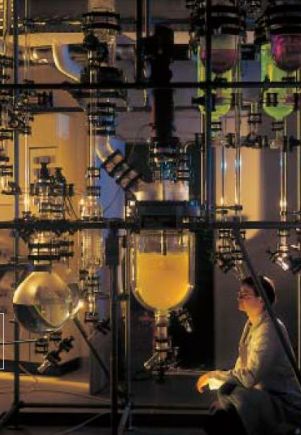Sol-gel — The sol gel process is a wet chemical technique (Chemical Solution Deposition) for the fabrication of materials (typically a metal oxide) starting either from a chemical solution ( sol short for solution) or colloidal particles ( sol for… … Wikipedia
Sol-Gel-Prozess — Der Sol Gel Prozess ist ein Verfahren zur Herstellung nichtmetallischer anorganischer oder hybridpolymerer Materialien aus kolloidalen Dispersionen, den sogenannten Solen. Die Ausgangsmaterialien werden auch als Präkursoren bezeichnet. Aus ihnen… … Deutsch Wikipedia
золь-гель синтез — Sol Gel Synthesis Золь Гель синтез (гелевая технология) Технология получения материалов с определенными химическими и физко механическими свойствами, включающая получение золя и последующий перевод его в гель. Основные технологические стадии… … Толковый англо-русский словарь по нанотехнологии. - М.
Ceramic engineering — Simulation of the outside of the Space Shuttle as it heats up to over 1,500 °C (2,730 °F) during re entry into the Earth s atmosphere Ceramic engineering is the science and technology of creating objects from inorganic, non metallic… … Wikipedia
Michael Veith (Chemiker) — Michael Veith demonstriert die Selbstentzündung nanoskaliger Eisenpartikel Michael Veith (* 9. November 1944 in Görlitz) ist ein deutscher Chemiker. Er ist Wissenschaftlicher Geschäftsführer am INM – Leibniz Institut für Neue Materialien in… … Deutsch Wikipedia
Zinc oxide — Other names Zinc white Calamine Identifiers … Wikipedia
Titanium isopropoxide — Chembox new ImageFile = Ti(OiPr)4.png ImageSize = IUPACName = Titanium isopropoxide OtherNames = Tetraisopropyl titanate Titanium(IV) i propoxide Titanium tetraisopropoxide Tetraisopropyl orthotitanate Section1 = Chembox Identifiers CASNo = 546… … Wikipedia
amorphous solid — ▪ physics Introduction any noncrystalline solid in which the atoms and molecules are not organized in a definite lattice pattern. Such solids include glass, plastic, and gel. Solids and liquids (liquid) are both forms of condensed… … Universalium
Nanoparticle — In nanotechnology, a particle is defined as a small object that behaves as a whole unit in terms of its transport and properties. Particles are further classified according to size[1] : in terms of diameter, coarse particles cover a range… … Wikipedia
Colloidal crystal — A colloidal crystal is an ordered array of colloid particles, analogous to a standard crystal whose repeating subunits are atoms or molecules.[1] A natural example of this phenomenon can be found in the gem opal, where spheres of silica assume a… … Wikipedia
 Золь-гель–реактор для синтеза мелких частиц
Золь-гель–реактор для синтеза мелких частиц